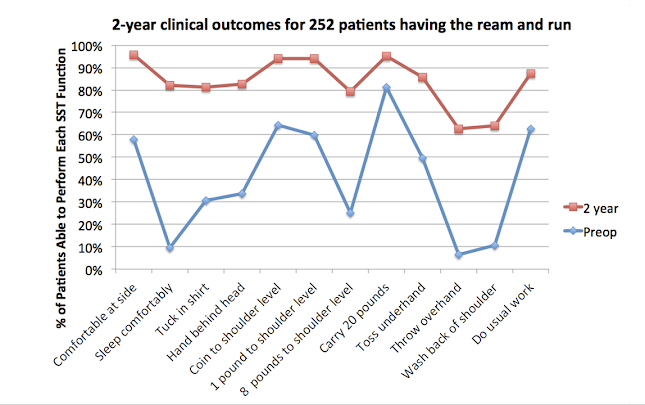In this era where many new innovations in shoulder arthroplasty are being brought forward, the incremental clinical value of each of these innovations can only be measured by assessing whether they improve patient self-assessed comfort and function to a greater degree than the methods in current use.
To document patient self-assessed comfort and function after different approaches to shoulder arthroplasty, we continue to use the Simple Shoulder Test (SST) introduced by Douglas Harryman and Steve Lippitt in 1993 because
(1) The "low tech, low cost" nature of the SST optimizes longitudinal participation by a high percentage of patients by avoiding barriers (such as the need to travel for an in-person examination or the need for a computer interface). In this way, the risk of selection bias can be minimized.
(2) The SST documents the patient's ability to perform important individual functions before and sequentially after any type of shoulder arthroplasty, providing granularity not available from single numerical scores.
(3) The SST eliminates concerns regarding inter-observer variability, observer bias, and industrial influence, thereby enabling meaningful comparisons among procedures and centers
(4) Consenting patients are prospectively enrolled by the research staff. After enrollment, the followup is managed by the research staff, completely independent of potential interference from the surgical team. The result is a high level of continued participation over time following the arthroplasty.
We are celebrating our 2000th patient prospectively enrolled in the Shoulder Research database. We are continuing to learn more about what improves the comfort and function of our patients.
Comments welcome at shoulderarthritis@uw.edu
You can support cutting edge shoulder research that is leading to better care for patients with shoulder problems, click on this link
Follow on twitter/X: https://x.com/RickMatsen
Follow on facebook: https://www.facebook.com/shoulder.arthritis
Follow on LinkedIn: https://www.linkedin.com/in/rick-matsen-88b1a8133/
Here are some videos that are of shoulder interest
Shoulder arthritis - what you need to know (see this link).
How to x-ray the shoulder (see this link).
The ream and run procedure (see this link).
The total shoulder arthroplasty (see this link).
The cuff tear arthropathy arthroplasty (see this link).
The reverse total shoulder arthroplasty (see this link).
The smooth and move procedure for irreparable rotator cuff tears (see this link).
Shoulder rehabilitation exercises (see this link).





